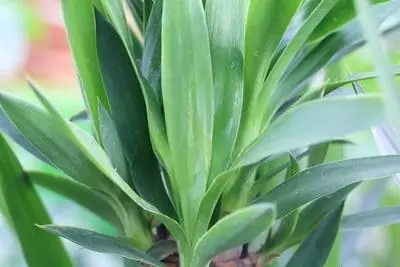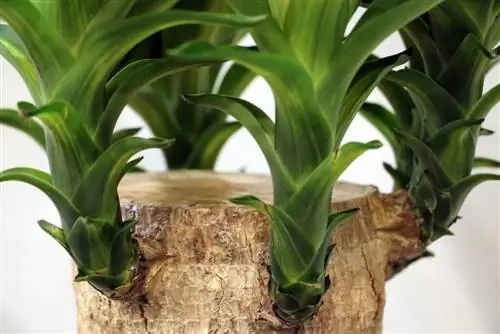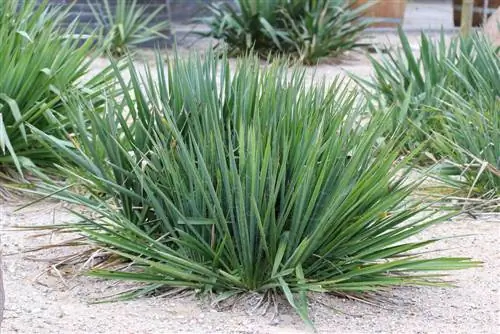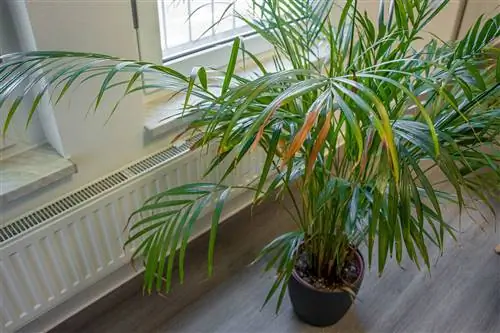- Author admin [email protected].
- Public 2023-12-17 03:39.
- Last modified 2025-01-24 12:45.
A palm lily immerses your home and garden in an exotic ambience without requiring extensive care. Many a hobby gardener started their career with a yucca in their living room. In summer, the palm lily in the garden produces white to cream-colored flowers on long, upright panicles. However, houseplant owners wait in vain for this spectacular flowering. The yucca usually only produces flowers when grown outdoors; this is unlikely to occur indoors. Nevertheless, the houseplant also has an irresistible decorative value.
Short profile
- Botanical name: Yucca
- other names: garden yucca, yucca, yucca palm
- belongs to the agave family within the asparagus family
- Flower and foliage plant, evergreen
- Growth height: up to 5 meters
- Species with and without stem
- Crown of hard-leaved, pointed leaves
Occurrences
The palm lily, botanically yucca, does not belong to the palm trees, but to the agave family within the asparagus family. With increasing age and height, many species develop a trunk that is around five to ten centimeters thick and looks slightly woody on the outside. At the top of the shoot there is a crown of radially arranged, elongated leaves that end in a dangerous, hard tip. The trunk of the yucca rarely branches and can grow up to five meters high if well cared for. The palm lily is native to the dry areas of Mexico and the western USA.
Location
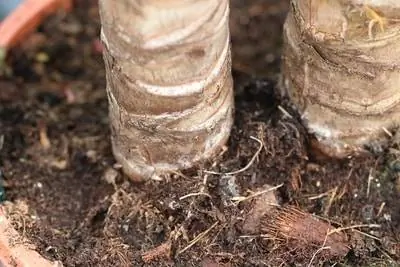
The Yucca palm finds perfect growing conditions in a protected, full sun and warm location in the garden. The soil should be nutrient-rich and well-drained for water, as the palm lily does not like waterlogging. Sandy or clayey soils, sometimes also calcareous, are optimal. But any well-drained garden soil is also tolerated by the evergreen plant.
- Light requirements: sunny to light partial shade
- Soil: rocky to loamy
- good drainage
- pH value: alkaline, neutral to slightly acidic
- medium nutrient content
- Temperature (non-hardy varieties): 10 to 27 degrees
Tip:
The palm lily fits perfectly into prairie and rock gardens due to its location conditions. For example, pearl baskets (Anaphalis triplinervis), lavender or sedum (Sedum) can be used as neighboring plants.
Plants (outdoors)
Because of their large distribution area, palm lilies have adapted to very different environmental conditions. While some grow in mountainous regions up to altitudes of almost 3000 meters, others are at home in mild coastal regions. Frost-resistant types of palm lily can be planted directly in the garden soil or cultivated in a flower pot. When planting, be sure to ensure good drainage in the soil. The irrigation or rain water must always be able to drain well. Therefore, if the soil is heavy, it is advisable to create a drainage layer made of pottery shards, gravel or chippings at an appropriate depth and to additionally enrich the soil with sand. Especially in winter, a wet root ball is often to blame for the palm lily not surviving spring.
- Time: Spring or Autumn
- Planting hole: at least three root balls
- create drainage for heavy soils
- about 40 to 50 cm deep
- Fill in 10 cm gravel, clay granules or chippings
- Make soil more permeable with sand
Tip:
When planting in autumn, winter protection is advisable in the first year.
Pouring
Although the yucca is one of the plants that only needs a little water, the root ball must not dry out completely. If the plant is left dry for a long time, the lower leaves on the trunk turn yellow and eventually dry up. Palm lilies love calcareous soil, so calcareous irrigation water is not a problem at all in this case. The palm lily reacts sensitively to waterlogging. Once the plant begins to rot due to excessive moisture in the root area, it can usually no longer be saved. The diving method is ideal for watering the yucca palm in summer if it is kept as a houseplant. The pot is placed in a container with water and only removed when no more air bubbles appear. Afterwards, excess water should be able to drain off easily. The next watering is only necessary when the bale is already relatively dry again.
Fertilize
On very sandy soils, the garden yucca is happy to receive organic fertilizer with compost or long-term fertilizers such as horn shavings or horn meal in spring. On nutrient-rich soils, additional fertilization is not necessary. Indoor and container plants can be fertilized with liquid fertilizer once a week during the growing season. If there is a good supply of nutrients, the palm lily grows quickly. If the Yucca palm grows larger, fertilization should be reduced slightly for practical reasons.
Cutting
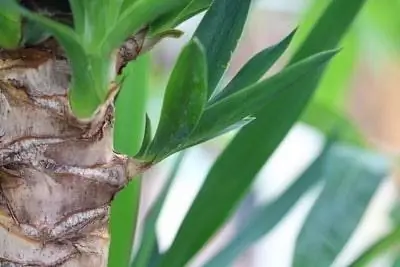
A he althy Yucca palm does not need to be cut. Only wilted leaves and inflorescences should be removed regularly. If the yucca becomes too large, this is not a problem. You can simply cut or saw off the trunk at any height. This works best in spring. Since the interface is usually quite large, pathogens can enter through the wound. Therefore, it should be coated with a wound closure (tree wax) available from specialist retailers. After a few weeks, the trunk will sprout again just below the cut point. By the way, you can use the cut top piece to propagate the yucca.
Repotting
The palm lily requires a deep pot rather than a wide one, as its roots spread predominantly downwards. For sufficient stability, it is best to use a heavy clay pot. If the previous container is no longer sufficient, the yucca is repotted after winter rest.
- Time: Spring
- Substrate: potted plant soil
- Potting soil with lava granules and sand
- Don’t forget the drainage layer
Propagate
The propagation of the palm lily is unproblematic because there are various methods that even beginners can carry out.
Trunk cutting
If the yucca palm in the room becomes too big, the trunk can simply be cut off anywhere. In this case, the upper piece with the leaf tuft is used to propagate the plant because it roots relatively easily and quickly in the substrate.
- Time: Spring
- Seal cutting surfaces
- Stick about 10 cm deep into the substrate
- Substrate: low in nutrients (e.g. coconut hum, potting soil or cactus soil)
- don't keep it too moist!
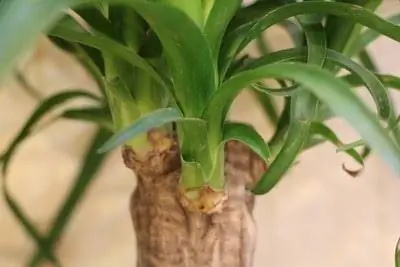
If the cut segment is very long, several new plants can be grown from the section. The trunk pieces should not be less than around 20 to 30 cm long. It is important to replant the trunk segments the right way round and not to stick the top edge into the substrate. If necessary, simply mark the trunk at the upper cutting edge before cutting.
Division
Yucca species that do not form a stem can also be propagated vegetatively. In most cases, offshoots have already formed on the plant and are well rooted. To do this, the older plant is dug up and the roots are carefully pulled apart. Each individual plant can then be planted back into the bed with some fresh substrate.
offshoot
Older specimens of the Yucca provide material for propagation even without the gardener's involvement. These are offshoots, so-called Kindel, which form at the base of the trunk. These children already have the appearance of a miniature palm lily. To ensure that these daughter plants develop their own root system, proceed as follows:
- there must be at least five leaves on the cutting
- Cut the child close to the trunk with a knife
- plant in substrate
- Planting depth: depends on the size of the offshoot
- just deep enough that the young plant doesn't fall over
- Substrate: potting soil, potting soil with sand, pricking soil
- place in a partially shaded location
- Keep substrate minimally moist
Tip:
The cuttings should only be planted outdoors when temperatures are over 18 degrees. Plants grown over the summer can be placed in the bed immediately after rooting. Late-grown Yucca offshoots still spend the winter indoors.
Wintering outdoors
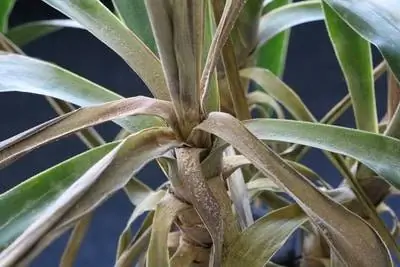
If you plant the palm lily in autumn, you should immediately provide it with winter protection made of brushwood, leaves or straw. The problem in winter is less the cold - the garden yucca (Yucca filamentosa) tolerates frosts well - but rather the waterlogging of the soil. Frost-hardy palm lilies that are in pots on the terrace or balcony also need to be protected from winter moisture. Therefore excess water must be able to drain away easily. It is best to remove the coaster. It is ideal if the bucket is not placed directly on the ground. A Styrofoam plate or special feet, which are available at the garden center, offer a good solution. As a rule, garden yucca plants such as Yucca filamentosa are hardy down to around -20 degrees.
Wintering in the house
Potted plants that are kept indoors all year round or even part of the time need a little less water in winter. Instead of diving, it is better to water a small amount every now and then during this time. The Yucca elephantipes, which is offered as a houseplant, is usually not frost-hardy and must therefore be overwintered in a warm place. It can also be placed in heated rooms without any problems, because the low humidity doesn't bother the plant much. It is important that the palm lily is bright even in winter. A cool (but frost-free) winter quarters is also possible. Temperatures should not fall below 10 degrees.
Diseases and pests
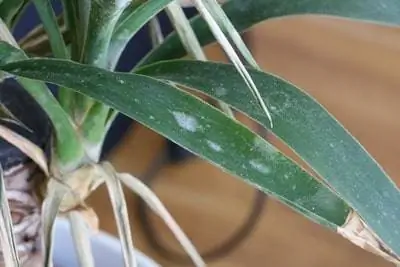
Yucca palms are rarely affected by diseases and pests. Only houseplants occasionally have problems with lice. Wet root balls cause more damage, especially to outdoor plants in winter.
Popular species
There are different types of palm lilies, some of which are suitable for cultivation outdoors. Others cannot tolerate frost and therefore have to be brought indoors at least in winter.
Hardy palm lily species
- Yucca filamentosa (stemless palm lily, filamentous palm lily): also frost hardy in the pot down to -15 degrees, stemless variant
- Yucca gloriosa (candle palm lily): hardy down to -20 degrees, branched trunk
- Yucca rostrata (blue palm lily): frost hardy down to -21 degrees, stem-forming, bluish leaves
- Yucca nana (dwarf palm lily), small-growing species without a trunk, frost hardy down to -20 degrees
- Yucca rigida (blue palm lily): silvery-blue leaves, frost hardy down to -12 degrees
- Yucca torreyi (Torrey palm lily): very large species with a height of up to 5 meters, very resistant to frost
Non-frost hardy palm lilies (houseplants)
- Yucca elephantipes (tree-like palm lily, giant palm lily): in summer on the balcony or terrace, from October in a bright place in the house
- Yucca aloifolia: up to 100 cm trunk height, dark green sword leaves, sometimes red-edged, not hardy
Conclusion
The yucca palm is a very easy-care plant that can survive dry periods well. When buying a palm lily, you should consider its future location, as there are both frost-resistant species that can be cultivated outdoors and cold-sensitive palm lily species that must be kept as indoor plants.

